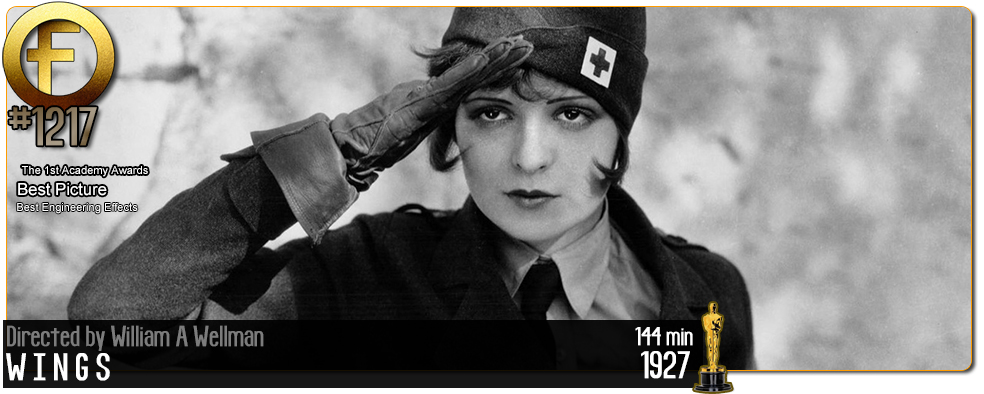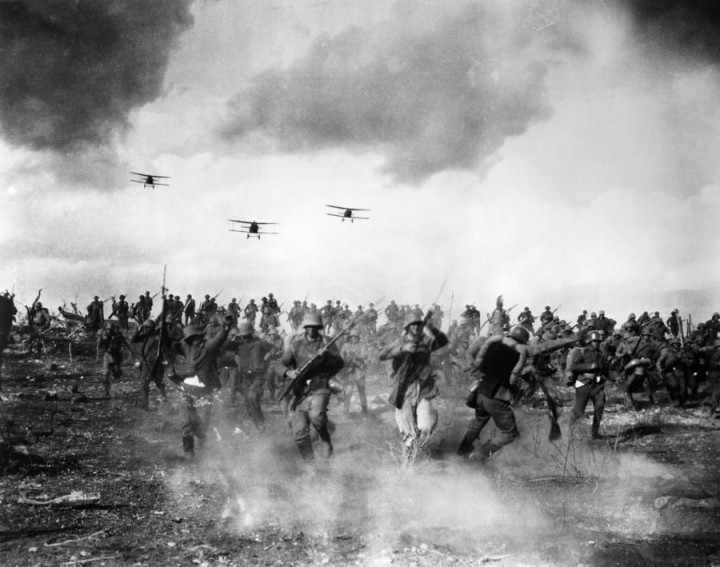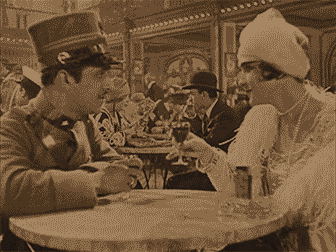Movie Review – Wings (1927)

Principal Cast : Clara Bow, Charles “Buddy” Rogers, Richard Arlen, Gary Cooper, Jobyna Ralston, El Brendel, Gunboat Smith, Roscoe Karns, Henry B Walthall, Julia Swayne Gordon, Arlette Marchal.
Synopsis: Two young men, one rich, one middle class, who are in love with the same woman, become fighter pilots in World War I.
*******
Wings was the first film win the Academy Award for Best Picture. Once thought lost, the film was rediscovered (exact date unknown) in a badly decayed nitrate print in Paris; the print was immediately struck to a safety negative, and then in 2012 given a full restoration, rerecorded orchestral score, and full HD presentation on DVD and BluRay. The original release ran 111 minutes, and the restored version (no doubt including some nudity and “adult themes” were cut before it made it to US cinema screens) clocks in at nearly two and a half hours.
Wings might be antiquated claptrap about World War I, delivering an assumed glorification of militarism and aerial pursuit, but hell if it isn’t a cracker of a movie. Ostensibly a mix of Michael Bay’s Pearl Harbor, a little bit of Titanic, and a whole plane-load of patriotism and glorious honour, Wings’ thrilling combat sequences offer effective means for director William Wellman, himself a former flight veteran in the War, to give audiences as close a look at what it was like to be up there in the air with bullets and explosions occurring all around. Co-starring Chuck Rogers and Richard Arlen, as two men smitten with the same woman, and Paramount superstar Clara Bow, as the girl whose affections for Rodgers’ Jack go unrequited, the film’s kettle-drum romantic subplot does kinda get a bit soap-opera-ish, but thanks to the charisma of the cast it all seems to work fine.

Man, what a glorious War. What a glorious film! Wings is a technical marvel – split-screen effects, overlaid effects, minor animation (bubbles), some utterly mesmerising use of framing, editing and focus, as well as its vaunted aerial combat sequences: this film has it all. As the first (and until 2011’s The Artist, only) silent film to win Best Picture, I went into Wings not really knowing what to expect other than possible melodramatic acting and clunky, stuttery “special effects”. To say Wings is an engaging, effective demonstration of the power of cinema, either silent or sound, is an understatement – the film’s captivating characters and disarming opening sequence setting us up for the horror of war is magnificent to watch. Okay, it’s not a Saving Private Ryan or a Black Hawk Down, largely because it casts the central characters as brave, heroes destined to fight in glorious battle (before we got the picture that war is hell) and that signing up en masse because the country needed men to fight was seen as a socially legitimate enterprise; Wings skirts propaganda a little, but remains as much an anti-war film as any other production, including All Quiet On The Western Front, which would win Best Picture a few years later.
Rogers (who, I have to say, looks surprisingly like a young Robert Downey Jr here) plays Jack Powell, a young man in love with local flirt Sylvia Lewis (Jobyna Ralston), who herself is in love with local rich kid David Armstrong (Richard Arlen). Jack is too caught up with Slyvia to realise that the girl next door, Mary (Clara Bow), is actually in love with him, and sees her more as a friend. When both men sign up to fly planes during the First World War, they initially despise each other, but through adversity eventually become good friends. Naturally, following a bit of shore-leave, David ends up in Paris, where he meets up with Clara again, before he’s called back into action, as the war has not abated.

Let’s face it, the old “girl loves a guy who doesn’t know she loves him and then he goes to war” routine isn’t exactly new – I guess it was back in 1927, though – and in this aspect Wings feels kinda dated. Thanks to the chemistry of the three main leads, though, the soap-bubble romantic subplot isn’t a problem, because the bright and bustling love elements work in contrast to the increasingly fraught combative aspects of the film’s action sequences. The first third of the film is essentially setting up Jack and David’s friendship, as well as delivering the rat-a-tat action sequences, comprising both ground and aerial sequences devised superbly by Wellman. Clara Bow skips in and out of the opening act, but disappears for a large portion of the film’s narrative, until popping back up as a driver in This Man’s Army, to largely comedic effect. Bow’s screen radiance is never dulled, those big beautiful eyes expressing every bit of her character as she laughs, smiles, giggles and gurns her way through a fairly derivative (to us) story.
Where Wings really…er takes off, is with the stunning depiction of the aerial dogfights and plane sequences. For a film of this vintage, I was legitimately blown away by just how astonishing the action sequences involving aircraft in flight actually were. This isn’t one of those “let’s shoot the stars against a screen because we don’t want them in harm’s way” film, this was a “no, I want to see the wind in their faces for realsies” kinda movie, and it shows. The rear-facing cameras aimed at the actors shows that the film was shot for-real, that is by carefully choreographed stunt pilots actually up in open cockpits, flying through actual clouds! Not only that, but sequences involving a small hamlet being bombed are just as graphic as any modern war film might depict! Visual authenticity is key to Wings, and probably goes a long way to explaining where the film’s $2m budget went.

Pilots hurling their planes through the sky, simulating dogfights and crashing aircraft (flames from the plummeting aircraft were hand animated in post production, and add a real feel of immediacy to the events depicted), gunfire blazing and the faces of terror as the real actors are shown up in the air doing it all for real is gasp-inducing. Exactly how Wellman achieved all the stunts and effects he did, I’m not sure, but the film’s attention to detail is this area is just superb. A post-intermission dolly shot in Paris, which pushes between several couples seated at cafe tables before stopping on David carousing with several damsels, is executed brilliantly, and actually took my breath away. I had to stop the film, rewind and watch that moment again just to see it in action. Wellman is to be applauded for the technical aspects of this film, largely because they’re as good to my eyes as many modern films in some respects.
I should point out that a large amount of the film’s enjoyment is in its superb musical accompaniment. The restored version has seen the original soundtrack score re-orchestrated for its new running time, and the wider soundscape goes a long way to giving life to the dialogue-free movie. Also of note, some sound effects (gunfire, punches, generally what you’d call foley work today) have been added from archival sources, and they provide some light humour and added wallop in key scenes. Watching poor El Brendel, as the naturalized-American, German-sounding Herman Schwimpf, get slapped about by the training officers, and even the active duty officers, is generally sweet natured slapstick, accompanied by the sound of a nice thick punch, and it works a treat.
Wings is terrific entertainment. Even today, its merits shouldn’t be underestimated for the newcomer to silent classic cinema. I had low expectations of the film before I went into it, and came out absolutely astonished by just how clever, wry, funny and downright devastating it is. Clara Bow – one of few silent superstars would would successful transition to talkies in years to come – is radiant as Mary, while Charles Rogers is youthfully charming as the film’s leading man, creating not only a slightly saccharine love story but a worthy grounding for the darkness of the film’s battle sequences. Wings is absolutely brilliant.
